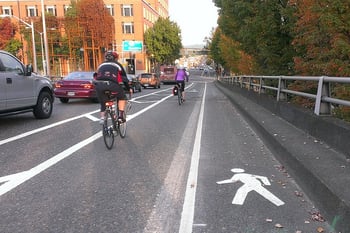 There’s something wrong with how we are taught to approach street design in America. The conventional transportation mindset dictates high speed and level of service for cars over long distances, which requires large arterial roads. Unfortunately, this approach ignores other modes of transportation such as bicycling and walking. While there’s a lot of talk about complete streets these days, I believe too often the conversation is still focused on cars.
There’s something wrong with how we are taught to approach street design in America. The conventional transportation mindset dictates high speed and level of service for cars over long distances, which requires large arterial roads. Unfortunately, this approach ignores other modes of transportation such as bicycling and walking. While there’s a lot of talk about complete streets these days, I believe too often the conversation is still focused on cars.
In this blog post, I’d like to share with you my thoughts on how we should fill the gaps in our engineering practice in order to achieve a healthy and complete street-type of transportation system based on my own experiences and research.
It starts by thinking beyond the automobile and looking at a street from the vantage point of a non-driver as well.
I used to work in an area where I could walk to some places to get food during my lunch break, but the atmosphere did not invite me to do so. Why? Because the roadways were not designed based on non-vehicular traffic modes, so access was not safe or convenient for pedestrians or bicyclists. While there were sidewalks, they were too narrow and in bad shape. There were no designated bike lanes. To access the commercial areas, I had to cross a very large, busy arterial road and a big parking lot, which was not inviting. Although I was willing to walk to get lunch in order to have a little bit of physical activity after hours of sitting behind the desk, I did not want to find myself the only pedestrian on the sidewalk and face the challenge of traffic safety as a pedestrian. It was during that time that I realized how much our roadway designs can impact transportation behaviors and physical habits.
By focusing primarily on automobile need, we make other modes of transportation lower priority. Following this mindset, we as transportation engineers design high capacity arterial roadways with a high speed to minimize traffic congestion for cars. Then we try to fit bike lanes and sidewalks into our design without considering how the roadway design might impact their use. Who wants to walk on a sidewalk for miles or ride a bike next to a large high-speed arterial? Or who likes crossing a series of 7-lane traffic intersections to get to their destination? In that situation, wouldn’t you choose to drive?
Beyond standard bike lanes and sidewalks, what can we as designers do to make the streets we design welcoming for all modes of transportation? The first step is to think of the street from the standpoint of a non-driver. Then we can consider one or more of these design measures:
- Roadway Transition Zones
- Roundabouts
- Entrance Features
- Lane Removals
- Lane Width Reductions
- Bulbouts
- Parallel or Head-Out Angled Parking
- Low Scale Lighting
- Protected Bikes Lanes or Cycle Tracks
- Textures
- Lateral Shifts (shorten views)
- Continuous Medians
- Short Medians
- Flush Medians
- Canopy Street Trees and Landscaping
- Wide Sidewalks
These measures can reduce the negative effects of motor vehicle use and alter driver behavior while improving conditions for pedestrians and bicyclists. They can also enhance the look of the route and create a more pleasant environment along the corridor.
The complete streets philosophy requires us to remember that “alternative” modes of transportation like walking, running, cycling, and mass transit are just as valid as driving your car. In this regard, the complete streets approach is a mindset as much as it is a series of potential design elements. By thinking beyond the automobile, we can create great streets that better serve everyone’s transportation needs.
Do you agree that our street design approach needs to change? What is your agency doing to promote the complete streets philosophy? Please leave a comment below – I would like to know what you think.
Photo Credit: Dianne Yee

